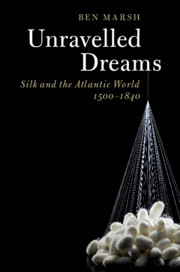Book contents
- Unravelled Dreams
- Unravelled Dreams
- Copyright page
- Dedication
- Contents
- Colour Plates
- Figures
- Maps
- Tables
- Acknowledgements
- 1 Prologue
- Part I Emergence
- Part II Persistence
- 5 Persistence
- 6 Lower South: South Carolina and Georgia
- 7 New England
- Part III Convergence
- Select Bibliography
- Index
- Plate Section (PDF Only)
6 - Lower South: South Carolina and Georgia
from Part II - Persistence
Published online by Cambridge University Press: 08 October 2020
- Unravelled Dreams
- Unravelled Dreams
- Copyright page
- Dedication
- Contents
- Colour Plates
- Figures
- Maps
- Tables
- Acknowledgements
- 1 Prologue
- Part I Emergence
- Part II Persistence
- 5 Persistence
- 6 Lower South: South Carolina and Georgia
- 7 New England
- Part III Convergence
- Select Bibliography
- Index
- Plate Section (PDF Only)
Summary
This chapter explores how colonial authorities and settlers, in first Carolina and later Georgia, made substantial efforts to introduce silkworms to the southern boundaries of British America across the late seventeenth and eighteenth centuries. These attempts at sericulture played a significant part in influencing schemes for and arguments about economic development in the Lower South. They generated innovation in the justification and practice of state investment; taxes paid for public enslaved labourers and their training, bounties, filatures; and the global sourcing of technical knowledge, experts, and technology. As with the French and Armenian immigrants to Virginia, stretching towards silk helped to bring Huguenots, Swiss, and Italians to the Lower South, to shape schemes for westward expansion, and to broaden the employment of enslaved people. The investment left cultural, material, and environmental legacies within many households, markets, and estates in the region, as mulberries proliferated. The depth of interest ensured that these well-supported initiatives generated noteworthy output, centralised in dedicated buildings (filatures), through which agents sought to control quality and improve proficiency. The conquest of silkworms appealed to many planters in search of metropolitan recognition, who in spite of later racialised claims, deployed their bondspeople widely in the pursuit.
Keywords
- Type
- Chapter
- Information
- Unravelled DreamsSilk and the Atlantic World, 1500–1840, pp. 238 - 311Publisher: Cambridge University PressPrint publication year: 2020

